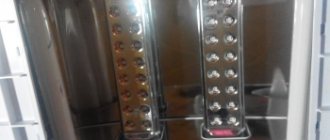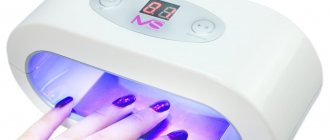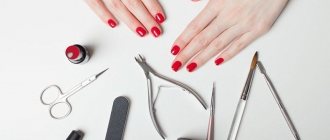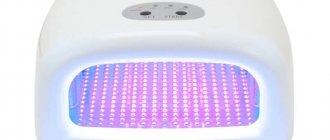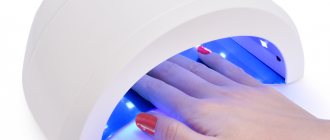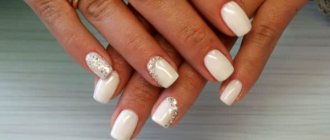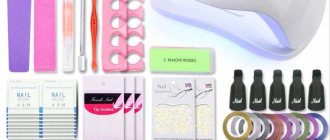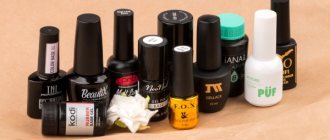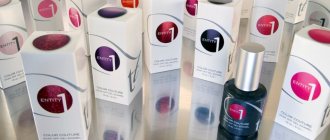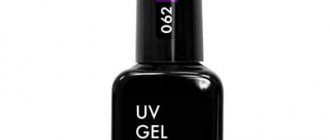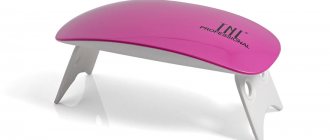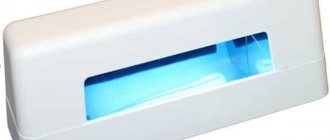Every manicurist who has been working for quite a long time, as a rule, has a whole cemetery of all kinds of nail lamps.
And although some of them are in working condition, they are no longer going to use them.
If you are just a beginner, how can you avoid all these mistakes when choosing and buy a truly working option that will serve for a long time and properly?
Let's look at all these nuances in more detail and help you make the right choice.
Types of lamps for manicure
Today technology has come quite far. Modern models have significantly changed both their appearance and functionality.
The most common are five types of lamps for drying manicures:
- ultraviolet (UV) – luminescent
- LED lamps
- CCFL with cold cathode coil
- hybrid – CCFL+UV
- hybrid LED - UV/LED
Differences between CCFL, Led, UV and hybrid
Although they are different, they all emit ultraviolet light.
The main difference is with what intensity and what wavelength they do this.
Light in general is a very interesting thing. And many things that seemed an axiom to us in school can be quite surprising in adulthood.
The first two types of lamps are more or less clear. They use well-known fluorescent and LED light bulbs.
What is CCFL? In CCFL models, as a rule, there is one spiral-shaped cold cathode lamp, without an incandescent filament.
Its upper location does not always allow uniform polymerization. Often, the spiral does not dry UV gels well on the sides of the arched fingers.
CCFL+Led combines two technologies at once. Here we already have a hybrid lamp. But we’ll talk more about this a little later.
Hybrid UV/LED are assembled entirely using LEDs, but with different emission spectra.
1 of 2
What is the fundamental difference between UV and LED bulbs? To understand this, take a look at the image below.
Here is the range of radiation and the difference in intensity and wavelength of these types. UV lamps have a wavelength from 280 to 400 nm. The ice is much shorter.
It turns out that ultraviolet lamps cover the entire range from mark 1 to mark 2 (see figure), but diode lamps do not.
A simple rule follows from this: if some material dries well in LED copies, then it will dry 100% in ultraviolet copies as well.
When this does not happen, look for an explanation in insufficient UV power or in a bulb that has lost its properties.
How much does a gel polish lamp cost?
1. Professional lamps have the highest prices on the market among analogues. CCFL and LED models will cost 20-50 thousand rubles. Ultraviolet ones will be a little cheaper - about 10 thousand rubles. The most expensive will be hybrid models - from 40 thousand rubles.
2. Chinese and domestic devices cost significantly less. UV lamps can be purchased for 3-5 thousand rubles, and CCFL and LED for 5-7 thousand rubles.
3. The lowest cost models are from little-known small manufacturers. They are simple and have limited optionality. You can buy such devices starting from 600 and ending with 2 thousand rubles.
What varnishes and gels dry different models
Inexpensive UV models with power up to 36W can cope with the following material:
- any gels, including LED
- biogels
- gel polishes
Less powerful ones can only work comfortably with transparent coatings. For example, finishing with gels.
Why do we need LED models if UV copes with such a wide range? Due to the longer wavelength in UV specimens, polymerization occurs gradually and takes much longer.
Even gel polishes dry in them in up to two minutes. They will also delay the hardening of the material.
That is, between the time you place your hand inside the device and the time when the gel polish stops spreading and somehow fixes, 20-30 seconds pass.
It is during this period that problems arise.
And in ice lamps everything happens in a matter of seconds. No matter how large the drop is.
That’s why professionals recommend diode models for beginners, although they are more expensive. But at least you will make fewer mistakes with them.
LED manicure lamps polymerize:
- gel polishes
- some biogels
- expensive LED gels
Well, in general, always be guided directly by the inscriptions on the bottles:
- LED – can be dried in LED or hybrid lamps
- UV/Led – universal material for all types
- UV only – dry in UV fluorescent, CCFL or hybrid
When there are no inscriptions at all, then apply as for UV. Now let's finish with the theory and move on to specific examples and brands.
Operating principle and design of a gel polish lamp
A gel polish lamp is a device that, using special light sources, causes the product applied to the nails to harden (polymerize). In a short time, waves of the required length transform the helium coating into a solid one. Thus, masters are able to create nail art masterpieces that will decorate nails for several weeks.
Visually, the lamp is a block made of durable plastic. It can be anything in size and shape, for example, small, accommodating only one finger, or suitable for drying all five. Products in the shape of a semicircle are very convenient, as they allow you to polymerize all the nails on one hand at once, without resorting to the scheme where four fingers are dried first and only two thumbs at the end.
Models are:
1. Cast;
2. Collapsible.
Often there is light-reflective material inside, which improves focus and enhances impact. Shutdown control is carried out using either a manual switch or an automatic timer, and lamps with both options are also available.
All devices need to replace lamps over time, the resource of which has been exhausted. Each type of device wears differently. If you do not change the light bulbs in time, drying will take more and more time.
LED models have a service life of up to 50 thousand hours, but after this time you will have to buy a new device, since the light bulbs cannot be replaced.
Ultraviolet lamp for manicure
Before purchasing a particular brand, ask yourself the question: for what purpose will you use the lamp?
If you are not yet a professional craftsman making money from this, but just want to apply gel polish yourself at home, then there is little point in buying an expensive branded LED hybrid lamp.
Take a closer look at UV options. The very first models for home use were 9-watt UV lamps of a similar design.
They have only one light bulb inside the housing. To be honest, it doesn't make much sense. The only thing it can dry is a transparent single-phase gel, which is very liquid in consistency.
There is no way to polymerize white, colored, or pigmented gels in it. Therefore, despite the attractive low cost, today professionals do not recommend buying such a lamp in principle.
Even for infrequent home use.
Also immediately discard any pocket or USB models. They are only suitable for fixing some small design elements.
But under no circumstances use them for full-time work. They simply do not have the power required to dry the entire coating.
As a result, you will get a negative result, and the varnish coating will not have shine and will not last long.
Meanwhile, with sufficient power and the right shutter speed, you can get a very beautiful result.
Design features
When choosing a table lamp for manicure, you need to pay attention to its design features and type of fastening. The most popular among professional craftsmen is the clamp type of fastening. The clamp is ideal for a stationary workplace, as the durable clamp perfectly holds the lamp structure on the table surface. However, this type of fastening is only possible on countertops with protruding edges.
The lamp on a stand looks stylish and is suitable for any furniture. The main thing is to choose a stable, compact stand that will not fall, will not take up much space and will not interfere with the work of the master. The third method of attaching the lamp is “clothespin”. It is increasingly offered by manufacturers, but the “clothespin” is not popular among professionals, since it is inferior to a clamp in terms of clamping strength.
When buying a lamp for manicure, you should definitely pay attention to its functionality:
- Can the lampshade rotate and direct the light flow in the desired direction?
- Is there or is there no adjustment of brightness parameters and functionality for choosing color temperature?
Today on the consumer market there are transformable lamps, models with brackets and flexible supporting structures. Which version of the lamp is more convenient is decided in each specific case by the manicurist himself.
What power and drying time is needed?
The minimum power required from a UV lamp is 36W. As a rule, the housings of such powerful specimens contain not one, but 4 light bulbs.
With this type you can polymerize absolutely any varnish that is on the market today.
Their main disadvantage is that drying takes a long time. This is usually a minimum of two minutes for colored gel polishes.
Even cheap LED ones take about 30 seconds.
Replacing UV Bulbs
Another disadvantage of ultraviolet lights is the frequent failure of the bulbs themselves. If you use it no more than once a week, then it will last you for a couple of years.
With constant work (5-6 clients per day), you will have to change the light bulbs every 3 months.
They are easy to change. Simply pull the old one out of the housing by the body and stick the new one in its place.
It would seem that this is not a big problem at all. One burned out, replaced with another. They are not that expensive - from 100 to 150 rubles.
The trouble is that when it fails, it is not entirely noticeable. The lamp will still emit violet-green light, but it will have virtually no UV intensity required.
As a result, the varnish will begin to shrink and dry poorly. If such symptoms appeared on a previously working lamp, remember how long ago you changed the light sources in it.
That is why experienced manicurists try to immediately write down the date of installation of the lamps, and if they work frequently, they change the set approximately every 3-4 months.
When you have to change all the lamps several times throughout the year, you end up wondering whether it was worth spending all that money on something better in the first place?
And don't forget that the light bulbs here contain mercury. And if you accidentally dropped it and broke it, then the process of demercurization of the room cannot be avoided.
Therefore, if you are willing to spend more, in this case, choose LED UV/Led lamps with a power of 36W.
Options for choosing a lamp for gel polish
Power
The strength and intensity of the heating elements located in the lamps depends on this parameter. The greater the power of the device, the higher the polymerization rate of the gel coating. However, we should not forget that powerful lamps for manicure consume more electricity, which ultimately affects financial expenses.
Before purchasing a high-power device, you should think about the feasibility and prefer average performance, especially if you have recently started working in this field.
Shape, size and weight
The shape of the lamp must be ergonomic to ensure comfortable work for the technician and convenience for the client.
The size of the device is selected individually: it can be a device for drying each finger individually or the entire palm at once. Experts still advise opting for more compact sizes, especially for those who work from home, leaving bulky lamps for stationary use to beauty salons.
Models of small weight and size are convenient to transport and store. For craftsmen who often go on business trips or provide services at a location specified by the client, it is best to buy lightweight products that will not weigh down their hand luggage too much.
Equipment and design
The configuration of lamps for drying gel polish can be very different. Everything will depend on how much you are willing to spend on the purchase.
Professional devices usually have a convenient removable bottom, reflectors, a fan, a timer function and many other options that can greatly facilitate the work of the master and make the manicure procedure more comfortable for the client.
The design of the models can be very diverse. The choice of colors, patterns, and additional decorations is simply huge. Each master will find a suitable one from the presented options.
Try to choose a lamp to match the style of your workplace, even if you are not a beauty salon employee and provide services at home. It will be much more pleasant for the client to be with the master, where he will receive not only a good manicure, but also aesthetic pleasure.
LED UV/Led lamps for nails
Low-power and miniature models can only be considered as a travel option for long trips on vacation. They have very small lighting angles and not all fingers can be dried equally well.
You will have to constantly twist your palm and look for a more or less comfortable position to grab the little finger.
The undisputed leader in sales among high-power UV/LED lamps is the SUN brand.
They have a great variety of models. And even masters sometimes get confused in the assortment.
According to the manufacturers, the LEDs here last up to 50 thousand hours during continuous operation.
However, these indicators should be treated with some skepticism.
As practice has shown, such a duration can be achieved only in two cases:
- economical operation with long cooling breaks
- modernization and integration of additional fans into the case
Without these conditions, your vaunted SUN lamps will last on average about 6 months.
SUN 5 lamp and others - comparison
One of the most popular models of UV/Led lamps is SUN 5 with a power of 48W.
It has an unusual capsule shape and four timers for 10-30-60-99 seconds.
The bottom is removable, with magnets. This is a great help for cleaning dirt and minor repairs.
Also, options with a removable bottom or without it at all on other varieties allow you to use them for pedicures.
Inside, in addition to LEDs, there are ventilation holes. True, there is no built-in fan.
But Sun One has it.
Many people are mistaken in thinking that it is necessary to air out the fingers and prevent the unpleasant burning sensation on the nails. The fan in powerful lamps primarily performs the task of cooling the LEDs. No more.
The lamps from this manufacturer are powerful and bright.
Almost everything is dried - extension gels, shellac, ice gels.
Many manicurists praise it without pointing out its shortcomings. And they also exist.
Flaws
What are these disadvantages? Firstly, the SUN 5 does not have a reflective surface on the bottom cover.
This means that with mirror correction, the nails underneath will not dry immediately. You will have to turn your palm over again and go through another drying process.
But the most important drawback is the large dead zone, almost class=”aligncenter” width=”720″ height=”481″[/img]
Not all clients put their hand far into the lamp.
And if at the same time the nails fall into this “dead zone,” then big problems arise. Especially with modeling gels.
Also check the tightness of the lid at the bottom. They often have large gaps.
What does this mean? Since the light breaks through, nothing should be placed next to the lamp. Otherwise, the brush or materials may polymerize randomly.
True, some people consider additional holes to be a good thing. They supposedly help prevent the LEDs from overheating and provide greater cooling. However, this is not the case.
It is not recommended to work with such a lamp for more than 2 minutes. For long corrections they are far from an ideal option. Moreover, they do not have a built-in fan.
Some craftsmen drill additional holes in the case and mount their own fan, just like on computer processors.
But even with such modernization, the heating temperature of the LEDs doubles in just a couple of minutes of illumination. From room temperature 20 degrees it instantly rises to 40!
What happens without forced airflow and only natural cooling? In this case, even the plastic begins to heat up and deform.
Also keep in mind that when overheated, the emitted ultraviolet spectrum may shift to longer wavelengths.
What does this mean for the client and for you? And the fact that some gel will begin to dry out worse than with a “cold” lamp.
It turns out that the first clients will leave satisfied, but the subsequent ones will not like the result of your work at all. At the same time, you will never understand what this is connected with. It seems that the gel is the same, and the lamp is the same, but the result is different.
After this, reviews appear on the forums that Sun lamps for manicure are not reliable and often burn out.
On AliExpress there are, of course, replacement diodes, but they are sold as a set and cost from 2 thousand rubles.
It is best to work with such lamps in 4-4-2 mode. That is, dry 4 fingers and let the lamp cool as much as possible while the other four are painted.
And only then move on to your thumbs.
Also, Chinese models do not always correspond to the declared power of 48W.
If you connect such a lamp not directly to a socket, but through a special wattmeter, you will be unpleasantly surprised.
Actual figures may differ by almost twice!
1 of 2
Those who actually faced all these problems gradually began to choose and try other models.
Here, for your convenience, is a comparative table of characteristics, advantages and disadvantages of the most popular manicure lamps produced under the SUN brand.
Here are SunOne, Sun5, Sun9s, Sun 9c plus:
Advantages and disadvantages of manicure lamp models
Today, everyone has a great opportunity, before buying anything, to study a huge amount of information on the Internet, compare characteristics, and look at reviews from happy and not so happy customers. As everyone notes, one of the main advantages of a manicure lamp is the ability to securely attach it to a table. This makes it very convenient, the lamp does not take up extra space, it will not accidentally fall, and at the same time it is always at hand. Let's look at what design features users put in first place, what you need to pay attention to first.
- Compactness . As we have already said, it is best if the manicure lamp is mounted on the side of the table, this saves space and adds comfort to work. Also, in general, consider small lamps so that they do not interfere, since the work area is already loaded with tools and materials for manicure.
- Price . Of course, there are very expensive models in stores, but in general you can always find the best option in terms of price-quality ratio. Even a housewife can afford to buy a manicure lamp and this will not be a blow to the family budget.
- Reliability . There is nothing special to say here; modern materials for the production of lamps are environmentally friendly and durable, and the service life of LED lamps is very long. Therefore, if you follow the operating rules, the manicure lamp will last a very, very long time without loss of quality and reliability.
- Convenience . Choose a model with the ability to adjust the height of the lamp and the direction of radiation. You will be able to direct the light where you need it, and your work will become a pleasure.
- Safety . The lamp should emit an even, constant light without any flickering, this will protect your eyes and prevent them from getting tired. Naturally, do not forget about electrical safety and the absence of overheating.
Essentially, a functional manicure lamp comes first, although a nice appearance doesn’t hurt. The main functions of the lamp are good illumination of the work area, this allows you to perfectly perform painstaking work without eye strain and ultimately get an excellent result. Secondly, good lighting ensures the safety of the manicure process and reduces the risk of injury.
Hybrid CCFL+UV lamp
However, speed is speed, but no less worthy results are shown by the so-called hybrid CCFL + UV lamps for nails.
They combine ultraviolet and diode light. Co-glow is useful when drying any capricious material.
Among the popular hybrid models is the Diamond 36W Led+CCFL. It is also called Diamond Stone Diamond.
It costs around one and a half thousand rubles. It has a compact shape and touch sensors. The timer here is for 10-30-60 seconds.
The bottom of the latest models is removable and magnetic.
36 watts consist of a 12W UV cold cathode coil and 24W LED diodes.
Below is a visual comparison on nail tips, drying capricious BMG gel polish in two different models.
We dried it in regular UV for 2 minutes and got the following result.
And in this hybrid Diamond it’s only 30 seconds.
In a hybrid, the varnish is completely dry and does not smudge. And in the ultraviolet there was shrinkage. There is nothing worse than dry polish.
Advantages of this hybrid option:
- average price category
- fast drying time
- compact size
But do not forget the disadvantages of CCFL - the upper location of the spiral and poor lateral drying of curved fingers. Service life and periodic replacement of lamps.
How to choose?
As you may have guessed, today’s market offers a wide range of models with a drying function. In order to choose the right model, you should carefully study the design features, characteristics and benefits. But you should understand that the dryer greatly affects the cost of the device.
When inspecting the assortment, you should first study the parameters. For example, if you do nail art professionally and have many regular clients, you should give preference to options with a large working area so that the client can dry both hands at the same time. This will save your time and shorten the duration of the procedure. Several lighting sources can be used for drying:
- Ultraviolet radiation for processing gel polishes and other coatings. The only drawback is the short service life.
- Ice devices for drying shellacs.
- Gas-light structures with a cold cathode. The operating principle is based on the use of gas during electrode radiation.
- Hybrid models - consist of several devices at once.
Advice! If you find that the product is overheating, replace the light source. It is quite possible that such phenomena are caused by its incorrect operation.
Which ones to choose
To summarize, we can draw the following conclusions. If you are looking for a lamp just for yourself and don’t want to waste extra money, then a UV lamp with a power of at least 36W will be quite enough for you.
If you are willing to spend a little more, then CCFL+UV hybrids with the same power of 36W are a decent option.
Well, when you want to become a master and work professionally with gel polishes, then your choice should look towards UV LED lamps from 48W with many functions and modes.
The best manufacturers of lamps for gel polish - which company to choose
The Russian market provides the widest selection of lamps for gel polish. There are quite budget options that are produced by domestic and Asian companies.
There are very good mid-range models of devices made by Russian-Chinese brands. These products are of good quality, nice design and affordable price. Most often, such products are purchased by novice craftsmen.
Professional products, mainly from American brands, are also presented. The lamps produced by them are in great demand all over the world.
Here is a list of some of the most popular brands:
- OPI;
- Harmony;
- Solomeya;
- CND;
- Gelish.
Experts do not recommend purchasing drying lamps from so-called nameless manufacturers, even though the prices for these products are very tempting.
Most often, such devices are made primitively, without any innovations, have a small range of capabilities, do not withstand frequent use and quickly break down. It is worth buying such copies only for the most superficial acquaintance.
If you are looking for a suitable model from a trusted brand, then go to our rating of the best lamps for gel polish.
Recommendations: 10 best lamps for drying gel polishes
10 Best Smart Light Bulbs
11 best devices for manicure and pedicure
